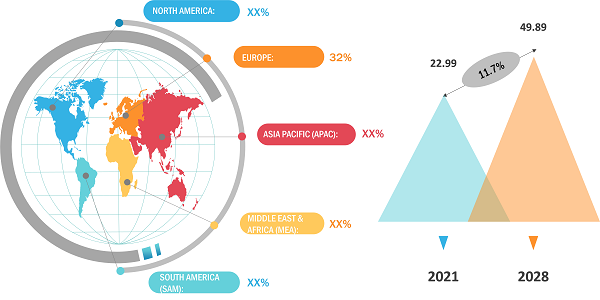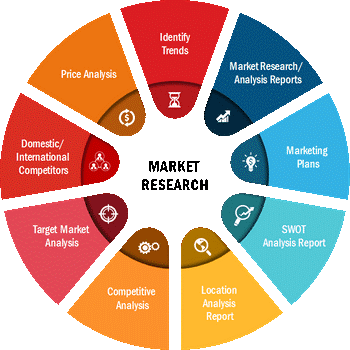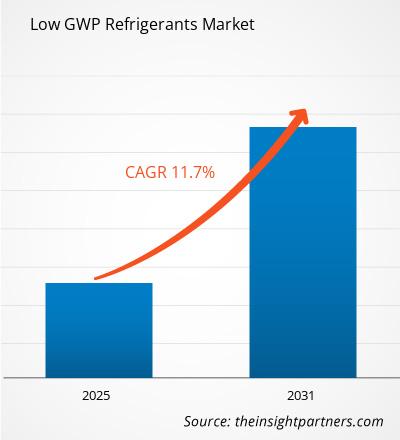Si prevede che il mercato dei refrigeranti a basso GWP crescerà da 22,99 miliardi di dollari nel 2021 a 22,99 miliardi di dollari nel 2021 49,89 miliardi entro il 2031 con un CAGR dell'11,7% tra il 2022 e il 2031.
I refrigeranti a basso GWP hanno varie offerte di prodotti in diverse categorie e applicazioni. La maggiore consapevolezza riguardo agli impatti dannosi dei refrigeranti convenzionali ha portato a una forte domanda di mercato dei refrigeranti a basso GWP. Sono richieste nuove offerte di prodotti, come i refrigeranti sintetici a basso GWP, poiché sono convenienti. Tuttavia, i refrigeranti naturali stanno crescendo in termini di domanda poiché non hanno effetti ambientali negativi a lungo termine. Tuttavia, i problemi associati ai refrigeranti a basso GWP, come le richieste di alta pressione, il potenziale Si prevede che l'infiammabilità e la tossicità freneranno la crescita del mercato a causa di importanti considerazioni sulla sicurezza.
DINAMICHE DEL MERCATO
Maggiore le applicazioni dei refrigeranti a basso GWP includono pompe di calore, aria condizionata e refrigerazione. Le grandi pompe di calore industriali e commerciali vengono utilizzate per fornire energia alle reti di teleriscaldamento o di teleriscaldamento. Queste pompe di calore utilizzano per lo più refrigeranti a base di ammoniaca della categoria naturale; tuttavia, l’uso di miscele sintetiche di HFO a basso GWP sta guadagnando importanza. I refrigeranti naturali a basso GWP più utilizzati nelle applicazioni di condizionamento dell'aria sono gli idrocarburi (per piccole applicazioni residenziali) e l'ammoniaca (per applicazioni di condizionamento centralizzato più grandi). Inoltre, la CO2 viene sempre più utilizzata nei supermercati sia per il condizionamento dell'aria che per la refrigerazione.
AMBITO DI MERCATO
I "refrigeranti globali a basso GWP" Market Analysis to 2031" è uno studio specializzato e approfondito del settore dei refrigeranti a basso GWP, con particolare attenzione all'analisi delle tendenze del mercato globale. L’obiettivo del rapporto è fornire una panoramica del mercato con una segmentazione dettagliata del mercato per categoria e applicazione. Si prevede che il mercato globale dei refrigeranti a basso GWP assisterà a una crescita elevata durante il periodo di previsione. Il rapporto fornisce statistiche chiave sullo stato del mercato dei principali attori del mercato e offre tendenze e opportunità chiave nel mercato dei refrigeranti a basso GWP.
SEGMENTAZIONE DEL MERCATO
Il mercato globale dei refrigeranti a basso GWP è segmentato in base alla categoria e all’applicazione. In base alla categoria, il mercato è segmentato in naturale e sintetico. In termini di applicazione, il mercato è classificato in pompe di calore, condizionamento dell'aria, refrigerazione e altri.
Approfondimenti strategici
Il rapporto fornisce una panoramica dettagliata del settore, comprese informazioni sia qualitative che quantitative. Fornisce una panoramica e previsioni del mercato globale dei refrigeranti a basso GWP in base a vari segmenti. Fornisce inoltre stime sulle dimensioni del mercato e sulle previsioni dal 2021 al 2031 rispetto a cinque regioni principali: Nord America, Europa, Asia Pacifico (APAC), Medio Oriente e Asia. Africa (MEA) e Sud America. Il mercato dei refrigeranti a basso GWP di ciascuna regione viene successivamente suddiviso nei rispettivi paesi e segmenti. Il rapporto copre l'analisi e le previsioni di 18 paesi a livello globale, insieme alle tendenze attuali e alle opportunità prevalenti nel mercato.
Dal punto di vista regionale, l'Europa ha dominato il mercato dei refrigeranti a basso GWP con una quota di mercato di circa il 32% nel 2021. Il dominio può essere attribuito alla presenza di un gran numero di produttori di refrigeranti a basso GWP. I principali produttori di refrigeranti a basso GWP nella regione includono The Danfoss Group, Honeywell International Inc., The Chemours Company e Arkema Inc. Questi fornitori testimoniano una domanda costante da parte dei produttori di condizionamento e refrigerazione.

Il rapporto analizza i fattori che influenzano il mercato dei refrigeranti a basso GWP sia dal lato della domanda che dell'offerta e valuta ulteriormente le dinamiche del mercato, vale a dire, fattori trainanti, vincoli, opportunità e tendenze future. Il rapporto fornisce anche un'analisi esaustiva delle cinque forze di Porter che evidenzia i fattori che influenzano il mercato dei refrigeranti a basso GWP.
IMPATTO DELLA PANDEMIA DA COVID-19
L'epidemia di COVID-19 ha influenzato negativamente la domanda di refrigeranti a livello globale, riflettendo volumi di ordini significativamente inferiori tra i produttori, con conseguente volume di produzione inferiore. Il calo dei volumi di produzione ha influito negativamente sulle attività di vari produttori del settore, compresi i produttori di refrigeranti a basso GWP. Pertanto, l'approvvigionamento di refrigeranti a basso GWP è diminuito durante la fase iniziale della diffusione di COVID-19, con un impatto negativo sulla crescita del mercato globale dei refrigeranti a basso GWP.
Il forte calo della domanda è stato osservato nel settore commerciale dell'industria chimica. Ciò è dovuto alla drastica chiusura dei luoghi pubblici in Nord America, Europa, Asia Pacifico, Sud e Stati Uniti. America Centrale e Medio Oriente & Africa. Tuttavia, dal 2021, i luoghi pubblici hanno iniziato a riaprire e si prevede che il trend di crescita continui. Ciò stimolerebbe l'approvvigionamento di refrigeranti a basso GWP, rafforzando così la crescita del mercato.
ATTORI DEL MERCATO
Il rapporto copre gli sviluppi chiave nel i refrigeranti a basso GWP commercializzano strategie di crescita organica e inorganica. Diverse aziende si stanno concentrando su strategie di crescita organica, come lanci di prodotti, approvazioni di prodotti, brevetti ed eventi. Le strategie di crescita inorganica nel mercato sono acquisizioni, partnership e collaborazioni. Queste attività hanno aperto la strada all'espansione del business e alla base di clienti degli operatori del mercato. Si prevede che gli operatori del mercato dei refrigeranti a basso GWP avranno opportunità di crescita redditizie in futuro con la crescente domanda di refrigeranti a basso GWP. Di seguito è riportato un elenco di alcune aziende impegnate nel mercato dei refrigeranti a basso GWP.
Il rapporto include anche i profili delle principali società del mercato dei refrigeranti a basso GWP insieme alla loro analisi SWOT e strategie di mercato. Inoltre, il rapporto si concentra sui principali attori del settore con informazioni quali profili aziendali, componenti e servizi offerti, informazioni finanziarie degli ultimi tre anni e sviluppi chiave negli ultimi cinque anni.
- •Honeywell International Inc.•Arkema Inc.• Dongyue Group Co. Ltd.•Daikin America Inc.•Shandong Yuean Chemical Industry Co. LTD.•The Chemours Company•Zhejiang Sanmei Chemical Incorporated Company •Il Gruppo Danfoss•Zhejiang Quzhou Lianzhou Refrigerants Co., Ltd.•Trust & Holdings, Inc.
Il team di ricerca e analisi dedicato del partner Insight è composto da professionisti esperti con competenze statistiche avanzate e offre varie opzioni di personalizzazione nello studio esistente.

- Analisi storica (2 anni), anno base, previsione (7 anni) con CAGR
- Analisi PEST e SWOT
- Valore/volume delle dimensioni del mercato - Globale, regionale, nazionale
- Industria e panorama competitivo
- Set di dati Excel



Report Coverage
Revenue forecast, Company Analysis, Industry landscape, Growth factors, and Trends

Segment Covered
This text is related
to segments covered.

Regional Scope
North America, Europe, Asia Pacific, Middle East & Africa, South & Central America

Country Scope
This text is related
to country scope.
Trends and growth analysis reports related to Chemicals and Materials : READ MORE..
The List of compaies
- Honeywell International Inc.
- Arkema Inc.
- Dongyue Group Co. Ltd.
- Daikin America Inc.
- Shandong Yuean Chemical Industry Co. LTD.
- The Chemours Company
- Zhejiang Sanmei Chemical Incorporated Company
- The Danfoss Group
- Zhejiang Quzhou Lianzhou Refrigerants Co., Ltd.
- Trust & Holdings, Inc.
The Insight Partners performs research in 4 major stages: Data Collection & Secondary Research, Primary Research, Data Analysis and Data Triangulation & Final Review.
- Data Collection and Secondary Research:
As a market research and consulting firm operating from a decade, we have published and advised several client across the globe. First step for any study will start with an assessment of currently available data and insights from existing reports. Further, historical and current market information is collected from Investor Presentations, Annual Reports, SEC Filings, etc., and other information related to company’s performance and market positioning are gathered from Paid Databases (Factiva, Hoovers, and Reuters) and various other publications available in public domain.
Several associations trade associates, technical forums, institutes, societies and organization are accessed to gain technical as well as market related insights through their publications such as research papers, blogs and press releases related to the studies are referred to get cues about the market. Further, white papers, journals, magazines, and other news articles published in last 3 years are scrutinized and analyzed to understand the current market trends.
- Primary Research:
The primarily interview analysis comprise of data obtained from industry participants interview and answers to survey questions gathered by in-house primary team.
For primary research, interviews are conducted with industry experts/CEOs/Marketing Managers/VPs/Subject Matter Experts from both demand and supply side to get a 360-degree view of the market. The primary team conducts several interviews based on the complexity of the markets to understand the various market trends and dynamics which makes research more credible and precise.
A typical research interview fulfils the following functions:
- Provides first-hand information on the market size, market trends, growth trends, competitive landscape, and outlook
- Validates and strengthens in-house secondary research findings
- Develops the analysis team’s expertise and market understanding
Primary research involves email interactions and telephone interviews for each market, category, segment, and sub-segment across geographies. The participants who typically take part in such a process include, but are not limited to:
- Industry participants: VPs, business development managers, market intelligence managers and national sales managers
- Outside experts: Valuation experts, research analysts and key opinion leaders specializing in the electronics and semiconductor industry.
Below is the breakup of our primary respondents by company, designation, and region:

Once we receive the confirmation from primary research sources or primary respondents, we finalize the base year market estimation and forecast the data as per the macroeconomic and microeconomic factors assessed during data collection.
- Data Analysis:
Once data is validated through both secondary as well as primary respondents, we finalize the market estimations by hypothesis formulation and factor analysis at regional and country level.
- Macro-Economic Factor Analysis:
We analyse macroeconomic indicators such the gross domestic product (GDP), increase in the demand for goods and services across industries, technological advancement, regional economic growth, governmental policies, the influence of COVID-19, PEST analysis, and other aspects. This analysis aids in setting benchmarks for various nations/regions and approximating market splits. Additionally, the general trend of the aforementioned components aid in determining the market's development possibilities.
- Country Level Data:
Various factors that are especially aligned to the country are taken into account to determine the market size for a certain area and country, including the presence of vendors, such as headquarters and offices, the country's GDP, demand patterns, and industry growth. To comprehend the market dynamics for the nation, a number of growth variables, inhibitors, application areas, and current market trends are researched. The aforementioned elements aid in determining the country's overall market's growth potential.
- Company Profile:
The “Table of Contents” is formulated by listing and analyzing more than 25 - 30 companies operating in the market ecosystem across geographies. However, we profile only 10 companies as a standard practice in our syndicate reports. These 10 companies comprise leading, emerging, and regional players. Nonetheless, our analysis is not restricted to the 10 listed companies, we also analyze other companies present in the market to develop a holistic view and understand the prevailing trends. The “Company Profiles” section in the report covers key facts, business description, products & services, financial information, SWOT analysis, and key developments. The financial information presented is extracted from the annual reports and official documents of the publicly listed companies. Upon collecting the information for the sections of respective companies, we verify them via various primary sources and then compile the data in respective company profiles. The company level information helps us in deriving the base number as well as in forecasting the market size.
- Developing Base Number:
Aggregation of sales statistics (2020-2022) and macro-economic factor, and other secondary and primary research insights are utilized to arrive at base number and related market shares for 2022. The data gaps are identified in this step and relevant market data is analyzed, collected from paid primary interviews or databases. On finalizing the base year market size, forecasts are developed on the basis of macro-economic, industry and market growth factors and company level analysis.
- Data Triangulation and Final Review:
The market findings and base year market size calculations are validated from supply as well as demand side. Demand side validations are based on macro-economic factor analysis and benchmarks for respective regions and countries. In case of supply side validations, revenues of major companies are estimated (in case not available) based on industry benchmark, approximate number of employees, product portfolio, and primary interviews revenues are gathered. Further revenue from target product/service segment is assessed to avoid overshooting of market statistics. In case of heavy deviations between supply and demand side values, all thes steps are repeated to achieve synchronization.
We follow an iterative model, wherein we share our research findings with Subject Matter Experts (SME’s) and Key Opinion Leaders (KOLs) until consensus view of the market is not formulated – this model negates any drastic deviation in the opinions of experts. Only validated and universally acceptable research findings are quoted in our reports.
We have important check points that we use to validate our research findings – which we call – data triangulation, where we validate the information, we generate from secondary sources with primary interviews and then we re-validate with our internal data bases and Subject matter experts. This comprehensive model enables us to deliver high quality, reliable data in shortest possible time.

 Ottieni un campione gratuito per questo repot
Ottieni un campione gratuito per questo repot